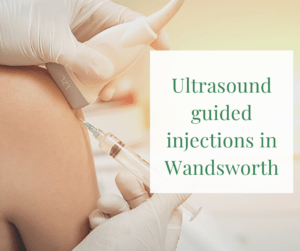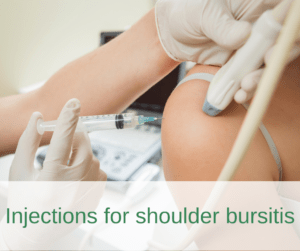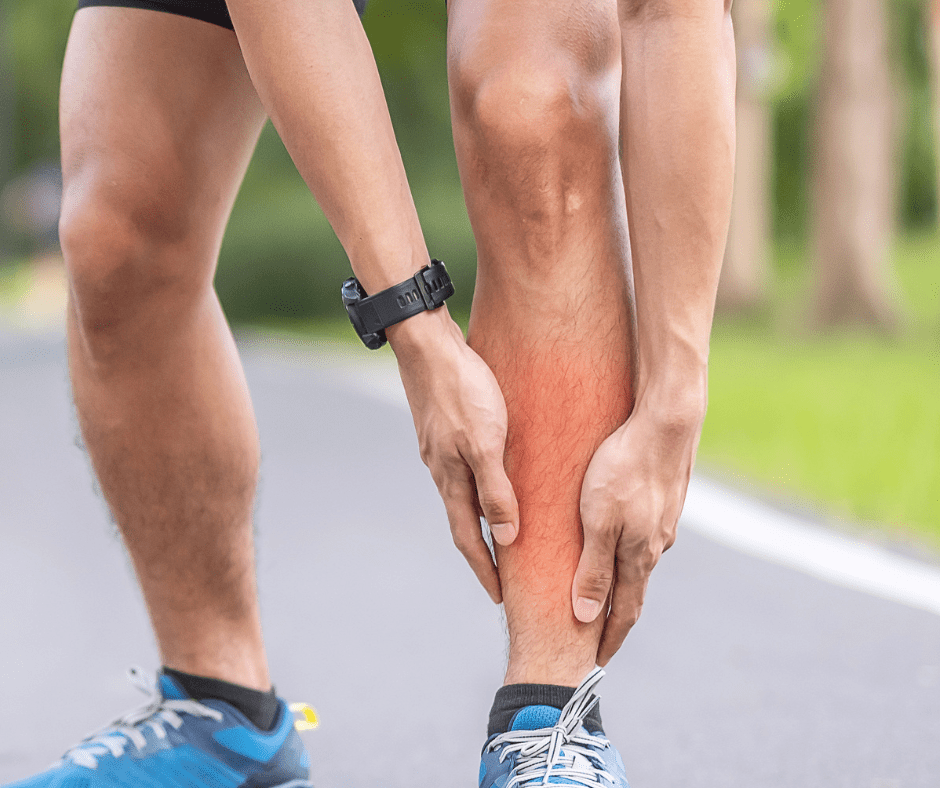Ultrasound guided injections for shoulder bursitis in Wandsworth

Shoulder complaints are the third most common reason for musculoskeletal GP appointments in the UK. Anywhere from 1.5% to 3% of adults present to their GP with shoulder pain at some point in their life. Women tend to report shoulder pain more than men with the peak age ranging from 45-64. Shoulder pain is an intransigent problem with almost half of all patients visiting their GP more than once (Artus et al 2017, van der Windt et al 1995, Linsell et al 2005, Friedman et al 2017). One of the most common shoulder problems comes from the rotator cuff tendons that sit in the subacromial space along with the subacromial bursa. This may be termed shoulder or subacromial impingement syndrome, subacromial bursitis or rotator cuff tendinopathy. Physiotherapy and strengthening exercises are usually very helpful in resolving rotator cuff problems, however what happens when you pain doesn’t improve? Ultrasound guided steroid injections for shoulder pain. Book a shoulder pain assessment and treatment session where we can assess, ultrasound scan and diagnose your shoulder pain.
Do subacromial steroid injections help?

Ultrasound guided injections into the subacromial bursa are usually performed with corticosteroid and local anaesthetic to reduce local pain and inflammation. However, it remains inconclusive as to whether corticosteroid injections are effective for the long-term resolution of subacromial impingement syndrome. It has been reported that subacromial steroid injections are affective for up to 9 months and superior to oral non-steroidal anti-inflammatory drugs (Messina at al 2015). A meta-analysis by Arroll and Goodyear-Smith (2005) was the first to show a significant benefit for subacromial corticosteroid injection versus placebo for a painful shoulder. The numbers needed to treat range between 1.4 and 2.2 patients and were clinically significant. More recently and contrary to Arroll and Goodyear-Smith’s findings a meta-analysis by Mohamadi et al (2017) found that corticosteroid injections provide minimal transient pain relief in a small number of patients with rotator cuff tendinitis at 4-8 weeks post injection. They found no differences three months after injection between steroid injection and placebo and for every five patients treated with a corticosteroid injection one would experience a slight, transient reduction of symptoms to mild pain. Mohamadi et al (2017) concluded SA/SD corticosteroid injections have limited appeal.
Are there other effective subacromial injections?
Ultrasound guided platelet-rich plasma (PRP) injections are now being used as an alternative to steroid injections as PRP contains more than 30 bioactive proteins such as growth factors within the platelets (Say et al 2016). Rotator cuff pathology (tendinopathy / tears) show reduced stem cell numbers, disorganised matrix and hypoperfusion (Phadke et al 2019). It is hypothesised that PRP injections improve these deficiencies. The evidence base for the use of ultrasound-guided PRP injection for rotator cuff tendinopathy and tears is still emerging, and due to heterogenicity of methodology it is still unclear as to its effectiveness. However, using PRP injections avoids the unwanted side effects of steroid injections such as steroid flare, fat atrophy or skin depigmentation.
There is a large body of research investigating the use of PRP in rotator cuff tendinopathy (Lin et al 2020). Say at et (2016) conducted a study on 60 subjects who were offered either a single dose injection of PRP or steroid for subacromial impingement. Both groups were also instructed to perform standard rotator cuff exercises for 6 weeks. Patients were evaluated before, and 6 weeks and 6 months after the injection. Patients that had the steroid injection fared better regarding self-reported pain at 6 weeks and 6 months compare to those who had the PRP injection. However, the study was not randomised, placebo controlled, and had a small cohort. Ibrahim at et (2019) also conducted a study to compare the efficacy of ultrasound guided PRP versus corticosteroid injection in the treatment of rotator cuff tendinopathy. 30 patients with RCT were randomly divided into two groups of 15 and received either ultrasound guided subacromial injection of 2ml of PRP or with a combination of 1ml methylprednisolone and 1 ml of lidocaine. Patients also did an exercise program for 7 weeks including rotator cuff strengthening exercises. Two months post injection there was a significant improvement in pain and range of movement in each group with no significant difference between the groups. Ibrahim at et (2019) concluded that steroid injections may provide symptomatic relief but do not promote healing which makes PRP injection a good alternative for RCT. Niazi et al (2020) assessed the effect of ultrasound guided PRP on patient symptoms and supraspinatus tendon thickness in cases of rotator cuff tendinopathy. Thirty subjects received a single injection of 5-7ml PRP into the subacromial bursa. This study showed a decrease in pain and an increase in function at four, eight, 12- and 24-weeks post injection, however there was no difference in tendon thickness until 24 weeks where tendon thickness reduced.
To date, studies demonstrate emerging evidence for the effectiveness of PRP for rotator cuff pathology, however, due to the heterogeneity in the study design (studies comparing PRP to placebo, steroid, physical therapy or dry needling) there is no consensus in the literature as to the number of injections, the site of injection (bursa or tendon), PRP preparation or the number of injections required.
Which injection should you have?
This is a discussion to be had with your treating therapist. It is still most common to start with an ultrasound guided steroid injection into the shoulder bursa to help settle pain and inflammation. If this hasn’t helped it is acceptable to move on to PRP or even a hyaluronic acid injection.
Ultrasound guided injections for shoulder pain
If you’re struggling with shoulder pain or think you have shoulder bursitis and want an ultrasound scan and discuss the option of an injection for pain relief call 0203 322 9455.
References
- Hamid M. S, Sazlina, S.G. (2021) Platelet- rich plasma for rotator cuff tendinopathy: A systematic review and meta-analysis. PLoS ONE 16(5): e0251111. https://doi.org/10.1371/journal. pone.0251111
Arroll, B. and GoodYear-Smith, F. (2005) Corticosteroid injections for painful shoulder: a meta-analysis. British Journal of General Practice. 1; 55 (512): 224-228.
Artus, M., van der Windt, D. A., Afolabi, E. B., Buchbinder, R., Chesterton, L. S., Hall, A., Roddy, E., Foster. N. E. (2017). Management of shoulder pain by UK general practitioners (GPs): a national survey. BMJ Open. 7: e015711
Blankstein, A., Ganel, A. Givon, U., Dudkiewicz, I., Perry, M., Diamant, L. and Chechik, A. (2005). Ultrasonography as a diagnostic modality in acromioclavicular joint pathologies. The Israel Medical Associa. tion Journal. 7 (1): pp 28-30.
Bloom, J. E., Rischin, A., Johnston, R. V and Buchbinder, R. (2012). Image‐guided versus blind glucocorticoid injection for shoulder pain. Cochrane Database of Systematic Reviews Review. https://doi.org/10.1002/14651858.CD009147.pub2
Bryant, L., Shnier, R., Bryant, C. and Murrell, G.A., (2002). A comparison of clinical estimation, ultrasonography, magnetic resonance imaging, and arthroscopy in determining the size of rotator cuff tears. Journal of shoulder and elbow surgery, 11 (3), pp.219-224.
Couanis, G., W. Breidahl, and S. Burnham. (2015). The relationship between subacromial bursa thickness on ultrasound and shoulder pain in open water endurance swimmers over time. Journal of Science and Medicine in Sport 18.( 4) pp. 373-377.
Daniels, E. W., Cole, D., Jacobs, B. and Phillips, S. F. (2019). Existing evidence on ultrasound-guided injections in sports medicine. The Orthopaedic Journal of Sports Medicine. 6 (2), 2325967118756576.
Finnoff, J. T., Hall, M. M., Adams. E., Berkoff, D., Concoff, A. L., Dexter, W and Smith, J. (2015). American Medical Society for Sports Medicine (AMSSM) position statement: interventional musculoskeletal ultrasound in sports medicine. British Journal of Sports Medicine 49: 151.
Friedman, M. V., Hillen, T. J., Holland, D. V., Essenberg, J. M. and Demertzis, J. L., (2017). Impact of shoulder sonography on clinical decision making. Journal of Ultrasound in Medicine, 36 (7), pp.1365-1371.
Gaitini, D. (2012). Shoulder Ultrasonography: Performance and Common Findings. Journal of Clinical Imaging Science (2) 38.
Girish, G,. Lobo, L. G., Jacobson, J. A.m Morag, Y., Miller, B., Jamadar, D. A. (2011). Ultrasound of the Shoulder: Asymptomatic Findings in Men. American Journal of Roentgenology. 197 (4): W713-9.
Ibrahim, D. H., El-Gazzar, N. M., El-Saadany, H. M. and El-Khouly, R. M. (2019). Ultrasound guided injection of platelet rich plasma versus corticosteroid for treatment of rotator cuff tendonopathy: effect on shoulder pain, disability, range of motion and ultrasonographic findings. The Egyptian Rheumatologist. 41: 157-161.
Le Goff, B., Berthelot, J. M., Guillot, P., Glémarec, J., and Maugars, Y. (2010). Assessment of calcific tendonitis of rotator cuff by ultrasonography: comparison between symptomatic and asymptomatic shoulders. Joint Bone Spine. 77 (3): pp 258-263.
Lenza. M., Buchbinder. R., Takwoingi, Y., Johnston. R. V., Hanchard, N. C., Faloppa, F. (2013). Magnetic resonance imaging, magnetic resonance arthrography and ultrasonography for assessing rotator cuff tears in people with shoulder pain for whom surgery is being considered. The Cochrane Database of Systematic Reviews. (9):CD009020.
Lin. M, T., Wei, K. C. and Wu, C. H. (2020). Effectiveness of Platelet-Rich Plasma Injection in Rotator Cuff Tendinopathy: A Systematic Review and Meta-Analysis of Randomized Controlled Trials. Diagnostics 10 (4)L 189.
Linsell, L., Dawson, J., Zondervan, K., Rose, P., Randall, T., Fitzpatrick, R. and Carr, A., (2006). Prevalence and incidence of adults consulting for shoulder conditions in UK primary care; patterns of diagnosis and referral. Rheumatology, 45 (2), pp. 215-221.
Mall, N. A., Kim, H. M., Keener, J. D., Steger-May, K., Teefey, S. A.,. Middleton, W. D., Stobbs, G. and Yamaguchi, K. (2010). Symptomatic Progression of Asymptomatic Rotator Cuff Tears. The Journal of Bone and Joint Surgery. 92: pp 2623-33.
May, S., Chance-Larsen, K., Littlewood, C., Lomas, D. and Saad, M., (2010). Reliability of physical examination tests used in the assessment of patients with shoulder problems: a systematic review. Physiotherapy, 96 (3): pp. 179-190.
Mesina, C., Banfi, G.,Orlandi, D., Lacelli, F., Serafini, G., Mauri, G., Secchi. F., Silvestri, E and Sconfienza, L. M. (2016). Interventional MSK procedures special feature: review article. Ultrasound-guided interventional procedures around the shoulder. British Journal of Radiology. 89: 20150372.
Mohamadi, A., Chan, J. J., Classen, F. M. A. P, Ring, D. and Chen, N. C. (2017). Corticosteroid injections give small and transient pain relief in rotator cuff tendinitis: a meta-analysis. Clinical Orthopaedics and Related Research. 475: 232-243.
Niazi, G. E., Hassan, M. S., and Elfawy, D. M. (2020) Ultrasound-guided injection of platelet-rich plasma (PRP) in rotator cuff tendinopathy: effect on patients’ symptoms and supraspinatus tendon thickness. Egyptian Journal of Radiology and Nuclear Medicine. 51: 111
Phadke, A., Singh, B., and Bakti, N. (2019). Role of platelet rich plasma in rotator cuff tendinopathy- clinical application and review of literature. Journal of Clinical Orthopaedics and Trauma 10: 244-247.
Porras, L. and Boggess, B. (2016). Economic analysis of accuracy and cost of ultrasound guided intra-articular hip injections. The Duke Orthopaedic Journal: 6 (1): 35-40.
Prashanth, S., Prasad, S., Nisha, P., Suresha, B and Nataraj, A. R. (2017). Comparative study of ultrasound and MRI in assessing rotator cuff tear. International Journal of Contemporary Medicine Surgery and Radiology. 2 (3): pp 70-74.
Prodromos, C. C., Finkle, S., Prodromos, A., Chen, J. L., Schwartz, A. and Wathen, L. (2021). Treatment of Rotator Cuff Tears with platelet rich plasma: a prospective study with 2 year follow‐up. BMC Musculoskeletal Disorders. 22: 499.
Say, F., Gurler, D. and Bulbul, M. (2016). Platelet rich plasma versus steroid injection for subacromial impingement syndrome. Journal of Orthopaedic Surgery: 24 [1]: 62-66.
Sayamanathan. A. A. and Andrew, T. H. C. (2017). Systematic review on risk factors of rotator cuff tears. Journal of orthopaedic surgery. 25 (1): pp 1-9.
Schmidt, W. A., Schmidt, H., Schicke, B., Gromnica-Ihle, E. (2004). Standard reference values for musculoskeletal ultrasonography. Annals of Rheumatic Diseases. 63: pp. 988–994.
Tempelhof, S., Rupp, S. and Seil, R. (1999). Age-related prevalence of rotator cuff tears in asymptomatic shoulders. Journal of shoulder and elbow surgery, 8 (4), pp.296-299.
van der Windt, D. A., Koes, B. W., de Jong, B.A., and Bouter, L. M. (1995). Shoulder disorders in general practice: incidence, patient characteristics, and management. Annals of Rheumatic Diseases. 54 (12): pp. 959–64.
White, E., A., Schweitzer, M. E, and Haims. A, H. (2006). Range of normal and abnormal subacromial/subdeltoid bursa fluid. Journal of computer assisted tomography 30 (2): pp. 316-320.




